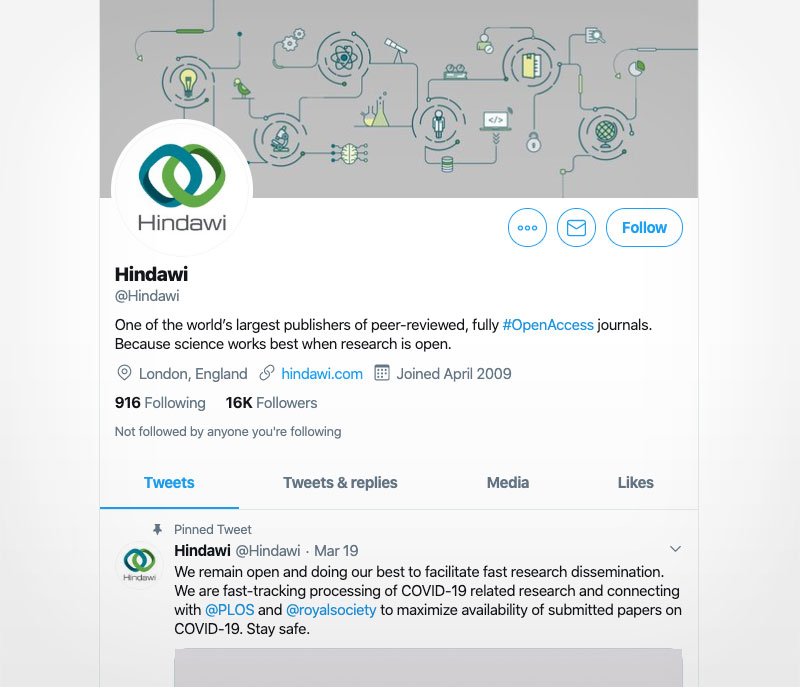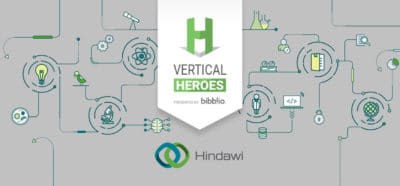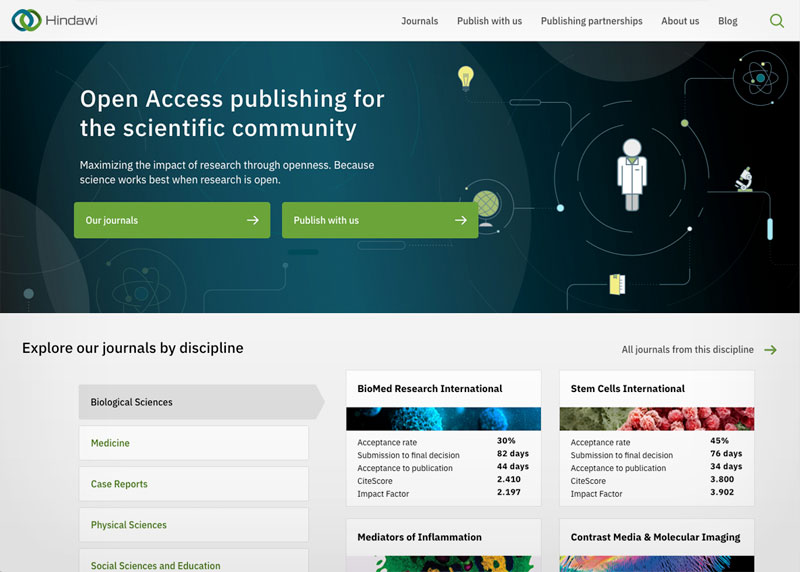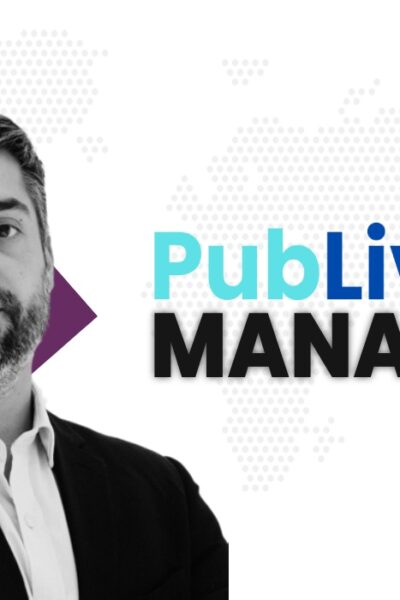We’re shining a spotlight on the many vertical publishers that are currently thriving. Welcome to the “Vertical Heroes” series of interviews.
With scientists and academics mobilizing to face down the COVID-19 pandemic, humanity’s hopes rest on what they discover through testing and research. Vast amounts have been written about coronaviruses and other contagious diseases, as well as the medical techniques required to face down this invisible enemy.
Publishers of scientific, technical, engineering and medical (STEM) are well placed to provide a valuable service across the coming months. Leading open access STEM publisher Hindawi, has more than 20 years experience serving researchers the world over, helping their research to be easily found, read, understood and shared.
Hindawi’s Director of Marketing, Mathias Astell spoke to Bibblio CEO Mads Holmen about being open access, cross-publisher partnerships and their three focuses of SEO.
 Mads holmen: hello mathias. Let’s begin by understanding Hindawi’s audience.
Mads holmen: hello mathias. Let’s begin by understanding Hindawi’s audience.
Mathias Astell: They are primarily international researchers working across all areas of STEM, but our journals are also relevant to, and attract an audience of journalists, policy makers, medical professionals and interested members of the general public.
Mh: what different types of content are you offering them?
MA: We publish 220 different academic journals that offer a variety of peer-reviewed academic and scientific articles covering all of STEM. We also run a popular blog which publishes spotlights of our journals’ editors, deep dives into specific articles, advice on effective science communication, insights from our staff, and industry updates.
Mh: how large is hindawi in terms of audience and team?
MA: We have a healthy flow of content and usage – publishing roughly 20,000 articles a year, with an average of 5 million users visiting our site and accessing articles each month. We have a relatively small staff of around 90 people in two offices (one in London and one in Iasi, Romania).
Mh: you’ve grown impressively – what has been the secret sauce?
MA: We take a tech, data and customer-first approach to our publishing and marketing activity. We aim to be at the forefront of the way in which people can submit, publish, discover, read and share scientific content. To help ensure the customers that are publishing content with us have the best experience possible, we have built all of our own publishing systems in-house – on a community-driven, open source code base. This means we can provide a much more modern and seamless experience when submitting and publishing research in our journals. It also means we are able to more effectively tailor our systems to our users’ needs and quickly make any changes as necessary.
With regard to our readers, all our content is published “open access” and so it is freely available for anyone to find and read. To further enhance this accessibility, we have recently relaunched our journal website to provide users with an even easier and more intuitive way to find and read scientific content. This approach to our publishing operations, coupled with innovative marketing techniques – that utilizes effective customer understanding and a range of channels to provide customers with relevant marketing when they want to receive it – has seen an increasing number of users visiting, reading and publishing with our journals.
Mh: how do you prioritize attracting new audiences vs. Engaging existing users deeper?
MA: There are a finite number of active researchers in the world and so ensuring we have as deep and rewarding relationship as possible with the researchers that interact with our journals is very important. Researchers also interact with us in a number of different ways (primarily as authors, editors, reviewers or readers) potentially simultaneously, and so we work to ensure that we understand the role people are playing when interacting with us and communicate with them accordingly.
Word of mouth plays an important role within scientific publishing and if a researcher has a good publishing or reading experience with a journal they will share this with their peers and colleagues – and so we aim to make sure that the experience our users have with our journals is the very best it can be. This way we attract new audiences organically while also strengthening the relationship we have with existing audiences.
Alongside this, we do work to raise awareness of our journals with relevant audiences through social media, search engine optimization and event marketing and in doing so we further support the existing and previous authors, editors and reviewers that have contributed to the journals, by raising their profiles. Publishing is a significant element of a researcher’s career, it is not just the route by which they share the results of their research; it factors prominently in career progression, building a reputation and finding international collaborators.
Our aim of research being as openly available and accessible as possible means we can help raise awareness of our researchers’ published work, which will benefit them on multiple levels, as it will benefit us.
Mh: what are the key audience metrics you define success by?
MA: We use the number of articles read, number of articles downloaded, number of times articles are cited, time spent reading article content, number of return users, number of submitting authors, number of publications, and the geographical spread of authors.
Mh: define what seo means to you these days. Are we talking keywords, page speed, engagement?
MA: Traditional ‘on page’ SEO methodologies are a challenge for most academic publishers. Keyword optimization is a good example, the nature of academic content means you have limited scope for amending phrasing or article structure to align with available search volumes. Load speed wise, pages are often impacted by the way that articles need to deploy large media assets to supplement their narratives (figures, tables, images, etc.), putting pressure on servers trying to deliver smoothly at scale. A high load speed for certain users is, in some cases, inevitable. Our core audience engagement is also tough to quantify, especially as an open access publisher where a portion of our readers are potentially not academics and so may have no immediate commercial value.
As such, our primary SEO focuses consist of 1) Discoverability, 2) Usability, 3) Availability.
Practically, ‘Discoverability’ refers to our efforts towards maintaining our presence in search listings and core external academic indexes. We mark-up articles with relevant academic schema for scholarly content and this provides as much context about an article to search engines as possible. We also actively monitor and amend issues presented to us in search engine developer tools (things like sitemaps, indexation issues, content warning and so on). Collaboration with third parties is also key, to ensure our journals are always part of the conversation. The resulting link profile supplements our visibility in search and adds credibility to our content.
‘Usability’ is the way in which we structure our website and content, ensuring our journals are easily navigated and contain the resources researchers need while browsing. A lot of work also goes into A/B testing, monitoring the performance of the servers and designing front end components that provide a good experience across all devices.
And finally, ‘availability’ of our content is the ongoing effort (in accordance with the principles of open access) to ensure our data is available in bulk to those who wish to use it and have the flexibility to work with anyone in order to pipe our article content to them. Part of our drive to openness in scientific publication is making content both human and machine readable – to this end, we provide XML feeds of all our articles, as well as our entire corpus as a single XML download. This bulk distribution is a core pillar of what we’re about, and something we are working to further build on in future.
Mh: what’s your social media strategy, and how important is it for you to be present on those platforms? Have you seen any trends?
MA: Social media plays an important role in our awareness and engagement strategies as researchers and academics are among some of the most active on platforms like Twitter, Facebook, LinkedIn and Reddit. There are also a number of industry-specific platforms, known as Scholarly Communication Networks (SCNs), that provide dedicated microblogging sites for researchers to find, share and discuss research (and other aspects of scholarly life).
As content is available from across publishers on SCNs, millions of researchers access them every day, so finding ways to ensure that our content is easy to find and read on these platforms helps to raise the profile of our journals, the research they publish, and the researchers that create it. As all our content is open access, it means full versions of all our articles can be made freely available on any site (as long as there is clear accreditation given to the original authors) and so we have a drive to disseminate our content as far as possible in this way.

Mh: do you work together with other publications in your vertical?
MA: Traditionally, collaboration between academic publishers has been through the medium of partnerships with other non-publishing bodies (usually governmental, charitable or NGO) who are working to tackle a specific problem within scientific research or publishing and join up with a host of publishers to help solve these problems – such as how to effectively create persistent identifiers for research, how to ensure data underlying research are shared, or how to support specific regions who have less funding for research.
At Hindawi however, cross-publisher partnership is at the heart of what we do. We provide a variety of publishing partnerships that enable other publishers, primarily through our open source publishing platforms, to take more control
of their workflows and output – aiming to provide the research community themselves (through the publishing arms of academic and scientific societies, as well as institutions and universities) with the ability to have greater visibility and understanding of the process by which their research is published.
We also run a number of journals in partnership with other commercial publishers (somewhat of a novelty in our industry), having worked with them to move these journals from closed subscription models to open access ones. Most recently, as a response to the COVID-19 pandemic, we have taken the somewhat radical (and almost completely unheard of) step for a commercial academic publisher to partner with a group of other publishers to send COVID-19 research to the publisher that it is most relevant for, and could be published the quickest by (if successfully passing peer review). We are essentially sending content to our competitors. However we have also taken the decision to waive publication charges for any papers relating to COVID-19 and so it makes even more sense to work closely with these other publishers so we can help make sure that the most relevant and useful research on COVID-19 is published as quickly and effectively as possible.
Mh: that’s great news. Let’s talk insights – would you describe your business as data-driven?
MA: All academic publishers (whether they realise it or not) are data driven. Our industry uses standardized metrics to measure a variety of areas, for example citations. There are also a multitude of unique identification methods at both author and article level, creating a structured uniformity that is relatively rare in other verticals.
This being said, most publishers only make basic use of this data. We’d certainly like to think we’re one of the most innovative academic publishers when it comes to our using the data we have, collecting what we don’t, and remaining robustly GDPR compliant.
This approach is most keenly evident in the marketing team, where Hindawi has a dedicated data team with a direct working link to colleagues orchestrating campaign strategy. In practical terms, this allows marketing teams to much more effectively analyze audiences, optimize existing activity and allocate resources more strategically. Other publishers have similar data teams but as we have full ownership of the systems that produce all our customer data, as well as strong connections to relevant external data sources, our ability to understand and utilize data is greatly enhanced.
This improves the relevancy of our communications, reduces dependencies on traditionally high yield markets, monitors the quality of submissions generated through marketing, and attributes marketing spend accurately. To the point where we can definitively say that X marketing produced Y publications and even that Z% of them have generated revenue – meaning our ROI calculations and reporting are solid, without inference.
Understanding the depth of our datasets is also key, giving us the capability to identify metrics that indicate whether or not an author/editor/reviewer/reader are more or less suitable for our specific objectives. At the moment, this specialist marketing data team pulls data from various internal and external sources on an ad hoc basis for analysis. The natural progression of that system (and our objective for the coming year) is to create a cloud-based, marketing insights database, integrating our core and peripheral datasets in one.
This would dramatically reduce the time from analysis to campaign delivery. But also, by leveraging the power of cloud services, we hope to build-in greater automation, machine learning, forecasting and ultimately develop more personalized and contextualized user life cycles. Whilst this objective is focused on our activities, we also ensure that we’re building systems that are in keeping with the principles of open access and so we want to be able to provide authors, editors, reviewers and readers alike with as much data on our portfolio as possible.
We already provide open journal dashboards (that transparently provide more data on our journals than many of our competitors) but building free-to-use APIs and more openly accessible datasets is also an important part of our longer-term data strategy.
Content from our partners
Mh: could you shed a bit of light on your revenue model?
MA: We operate a model that is known as Gold Open Access. It works by authors paying an Article Processing Charge (APC) upon acceptance of their article. Acceptance is still dependant on a submitted article passing editorial checks and the rigours of independent peer review. If an article is accepted (on average ~27% of the articles submitted to us get accepted), then the payment of the APC covers the costs of publishing and openly hosting the article online, as well as covering the author’s retention of full copyright of the article.
The traditional model in academic publishing is a subscription one, by which the author doesn’t pay anything, but individuals and institutions pay to access the content. In this subscription model, the publisher becomes the copyright holder of all published content and it is not openly or freely available for anyone to access – meaning valuable science can end up being locked away from researchers and the public alike, while the authors of published research lose the ownership (copyright) of their publications. So, an open access model allows us to fulfil a core element of our business mission – to help make the academic research that underpins science as open as possible. But also, because we operate an open access model it means we are primarily a B2C business (unlike the majority of our industry which is primarily B2B through subscriptions) and so we care very much about our end users, whether they are an author, editor, reviewer or reader. This means we put a lot of effort into understanding our end users and the different roles they are playing, as well as ensuring the ways we engage with them are as useful and effective as possible.
This is primarily because all of these end users are likely researchers and so have the potential become authors (that pay APCs), it is not only good for our users that we make sure we provide the best experience (no matter how they are interacting with us) it makes good business sense too. To help further support our core mission of opening up science, we provide full APC waivers for low and middle income countries to help ensure that a cost barrier isn’t simply moved from accessing the content (through subscriptions) to publishing the content. This helps to ensure that valuable research from all over the world is considered for publication in our journals, not just the research of countries that can afford to cover publishing costs. Although there is not a direct revenue benefit from this policy, it does enable us to publish a diverse range of global research and so provides richer content for our readers.
Mh: what’s your fastest growing area?
MA: One of the areas of our business that we spent time refining and improving over 2019 was our Special Issues program. Special Issues are collections of new articles that serve to highlight emerging areas of research within a field or provide a venue for a deeper investigation into existing research topics. The specific focus of Special Issues tends to produce high quality, timely articles and generate a greater level of interest, discussion and awareness around a dedicated topic.
We worked throughout 2019 to hone the processes by which we identify, invite, approve and promote Special Issues, and the result was a more rigorous procedure and a higher quality output. With this new procedure in place, we created a dedicated Content Development team to run the process and carry out new, expanded marketing efforts. In the first quarter of this year we have seen a wealth of new Special Issues being launched across many subject areas by researchers from all over the world. The quality of these Special Issues (and the researchers running them) is attested to by the fact that we have seen a 40% increase in submissions to Special Issues so far this year.
This is incredibly encouraging and the thing I am most excited about is the potential for Special Issues to provide opportunities for often underserved sections of the scientific community, such as early career researchers and those in the Global South, to raise awareness of their research.
Mh: from your own journey, what do you think other vertical publishers could learn?
MA: The key to our success has been not only the move to being fully open access but the fact that we own and operate all of our own primary systems (i.e. submission system, peer review platform and publishing platform). Owning these systems means we are able to have full visibility of the activities across all of our customers’ interactions with us. This really does allow us to ensure the services we provide to them are the best they can be and the marketing we carry out is as relevant and useful as possible because we don’t have the gaps in our understanding that are created when using proprietary, third-party systems in workflows.
Mh: can you share some milestones with us?
MA: Since launching our new website (in December of 2019) we have seen a strong increase in readers from across the world – up 25% in Q1 when compared to the previous Q1 – with mobile usage seeing a ~40% increase, the equivalent of 500k new mobile users each month.
We have also built a very strong user base and reputation in China over the past 5 years and we continue to see an increase in submissions and usage coming from China, which saw increases of 20% and 40% (respectively) between Q4 of 2018 and Q4 of 2019. To better serve this important customer base we launched our own China-specific social media account and blog in mid-2019 (through WeChat and ScienceNet), which have grown massively since launch, and we are also in the process of building and launching our own Chinese-language website.
Mh: which other publishers do you look to for inspiration?
MA: There are a number of publishers in our industry that also work tirelessly to push forward an open agenda and we are proud to call them colleagues and partners in this mission. Those such as The Public Library of Science (PLOS) and eLife, who are at the forefront of making cutting-edge research openly available; or The Royal Society, the oldest scientific publisher in the world, and BMJ (a leading medical publisher) that are pushing to find new ways to drive openness in publishing. These are just some of the publishers that are doing interesting, innovative things that inspire us to continue to find new and effective ways to make science easier to find, read, publish and understand.



 Mads holmen: hello mathias. Let’s begin by understanding Hindawi’s audience.
Mads holmen: hello mathias. Let’s begin by understanding Hindawi’s audience.







